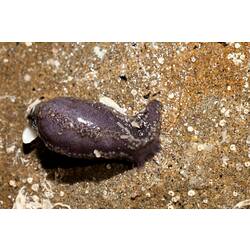General Description
Body soft, cucumber-shaped, grey-blue to grey-brown with fine dark flecks, oral (mouth) and anal ends usually black. Up to 5 cm long.
Biology
Females seasonally brood many small juveniles in an internal body cavity (coelom) during late winter for release in spring. By late summer one or a few large juveniles have been found in the coelom of some females, indicating that auto-ingestion/"cannibalism" occurs to enhance species survival.
Distribution
Southern Australia.
Habitat
Under or around the edges of rocks, and on seaweed, to depth of at least 6 m.
More Information
-
Animal Type
-
Animal SubType
-
Brief Id
Cucumber shape, greyish with black ends.
-
Colours
Grey, Blue, Brown, Black
-
Maximum Size
5 cm
-
Habitats
-
Diet
Organic matter
-
Endemicity
-
Commercial
No
-
Conservation Statuses
CITES: Not listed, FFG Threatened List: Not listed, DSE Advisory List: Not listed, IUCN Red List: Not listed
-
Depths
Shore (0-1 m), Shallow (1-30 m)
-
Water Column Locations
On or near seafloor
-
Taxon Name
-
Scientific Author
O'Loughlin, 2007
-
Common Name
Sea Cucumber
-
Phylum
-
Class
-
Order
-
Family
-
Genus
-
Species Name
materiae



